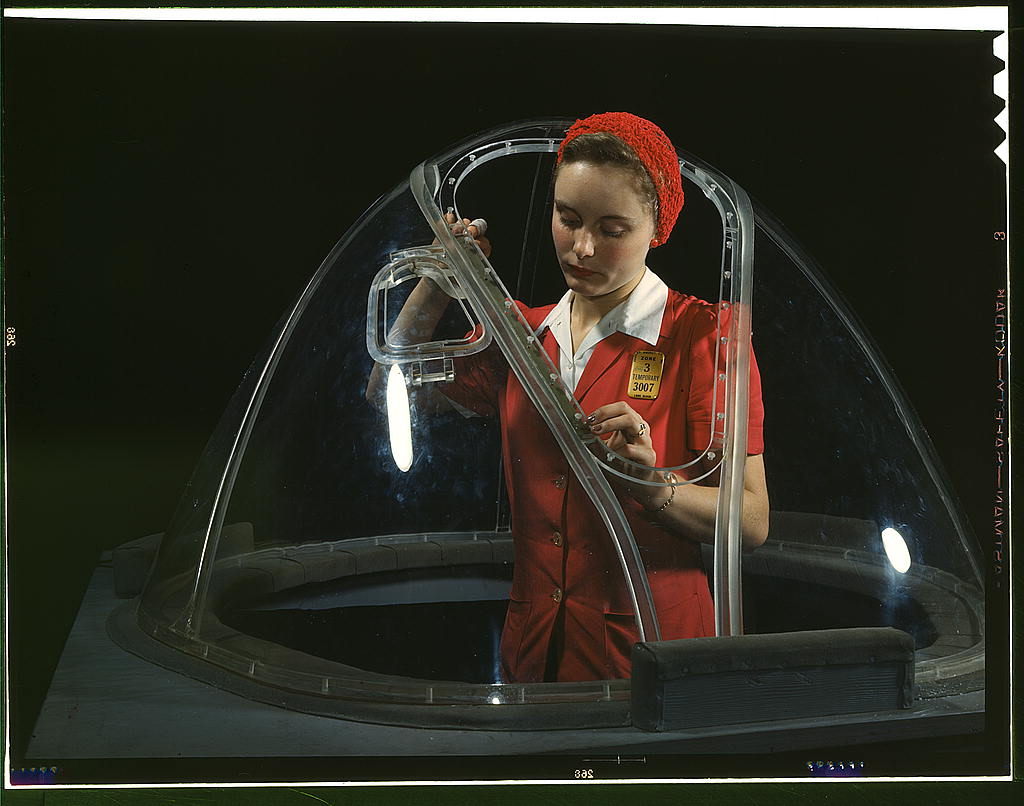 |
| Chris H. Groneman, John L. Feirer & John C. Spry. General Shop. Mc-Graw-Hill Co. of Canada Ltd., 1956. |
| http://www.rohmhaas.com/history/fromthearchive/photographs.htm |
 |
| "This girl in a glass house is putting finishing touches on the bombardier nose section of a B-17F navy bomber, Long Beach, Calif. She's one of many capable women workers in the Douglas Aircraft Company plant. Better known as the "Flying Fortress," the B-17F is a later model of the B-17 which distinguished itself in action in the South Pacific, over Germany and elsewhere." October 1942. Photographer: Alfred T. Palmer. http://www.flickr.com/photos/library_of_congress/2179137591/ |
One source credits a Canadian, William Chalmers, with the invetion of polymethyl methacrylate, as part of his doctoral thesis at McGill University in 1930 or 1931. This was the first workable transparent acrylic. He sold his patent to Imperial Chemical Industries (ICI) for $5000. ICI licensed it to DuPont and to Rohm and Haas for commercial production. Rohm and Haas quickly marketed their product as Plexiglas in 1936, while DuPont released their version, "Lucite" the following year. ICI marketed its product as "Perspex" in Great Britain.
The Rohm and Haas website gives a different story. Their company began in 1904 when a young chemist named Otto Rohm noticed that the waste products of the Stuttgart gas works where he was employed smelled like a leather tannery. At that time, fermented dog manure was used to soften or "bate" the leather preparatory to tanning. Unhygenic and unsavory, Rohm was eventually able to develop an alternative using enzymes from animal pancreases, and patenting this as "Oropon" in 1907.
“O stands for Oropon,
The Universal Bate,
The exceptional tanner who does without
Is simply Out of Date.”
– The Oropon newsletter, April 1920
The same year, he founded
a company with German businessman Otto Haas, followed by an American branch in
1909. After World War I, the two companies were legally separated, but
continued to share research. Their website credits Rohm with the
invention of PMMA while trying to develop a plastic
separator for the production of automobile safety glass. The new product's
application to automobiles was considered: as a publicity stunt, Rohm
and Haas teamed up with General Motors Pontiac division, to creat a
Plexiglass Deluxe Six car for the 1940's New York World's Fair, and a
second for the Golden Gate Exposition in San Francisco. According to
the June 2011 issue of Motor Trend,
the latter car is owned by the Smithsonian, while the former car
disappeared for years but recently reappeared and was put up for
auction. In any event, in both Germany and the U.S., the value of this
product to the military was quickly realized, especially as a
replacement for glass in bomber noses, canopies and gun turrets. In
Germany, it was used secretly (and in contravention of the Treaty of
Versailles) to make canopies for Luftwaffe bombers, with sales
increasing by a factor of nine. In the U.S., it became an essential
war product. According to the Evonik Industries website (now the parent company for the former German Rohm & Haas), Otto Rohm died
in 1939 and his son, being half-Jewish, had to leave for Switzerland. Because of its importance to the German aircraft industry, the German
Rohm & Haas plants were targets for heavy bombing during the war.
After the war, according to the American Rohm and Haas website, the company went on to develop a light-stable dye for plexiglass in 1946, opening up the civilian market, as well as developing the first acrylic latex paints in 1953. They also got into electronics, noting that in 1985 the average microchip contained 275,000 transistors but that, by the year 2000, this number had expanded exponentially to 42 million. While Rohm & Haas sold its Plexiglas business in 1998, in 1999 it acquired the iconic Morton Salt brand. When it rains, it pours.
After the war, according to the American Rohm and Haas website, the company went on to develop a light-stable dye for plexiglass in 1946, opening up the civilian market, as well as developing the first acrylic latex paints in 1953. They also got into electronics, noting that in 1985 the average microchip contained 275,000 transistors but that, by the year 2000, this number had expanded exponentially to 42 million. While Rohm & Haas sold its Plexiglas business in 1998, in 1999 it acquired the iconic Morton Salt brand. When it rains, it pours.

No comments:
Post a Comment